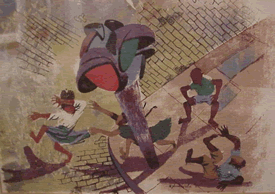Looking for the Roots of Tag
Listen to the Recess! Clip
| Author | John Cech |
| Air Date | 4/27/2006 |

Looking for the Roots of Tag Transcript
One of the most familiar, if not the oldest, of children’s games is “Tag” or one of its many variations, played on school yards, and in parks, backyards, and free spaces all over the world. It’s even played in swimming pools, where it’s called “Marco Polo.” Quite simply, it’s a chasing game, where one person is declared “It” and has to pursue the others until he can tag them. Often there is a safe spot, usually called “home,” — a tree, a door, a step, a tin can, a circle drawn on the ground — and if you can get there before “It” touches you, you’re free. But, if you’re tagged, then you’re out of the game, or you may change places with “It” and become the chaser.
One scholar thinks that the word for “tag”comes from the perfect tense of the latin verb, tango or “I touch” and that the word made its way over the Alps to Switzerland, where it got translated and became the last part of the word, “Eisenziggi,” and got shortened to “Tiggi.” The word migrated to England and Ireland where it became “Tig” (the Irish word for home) and then came to America where it morphed into games like “cross-tag” and “pickadill” and “turn-cap.” In this last game, “It” had to turn his cap inside out.
The earliest versions of the game, like the Italian Toccaferro, which literally means to “touch iron,” contained the idea that metal provided a means of rescue from the pursuer. The metal served as a kind of talisman or perhaps a weapon — both of which could be used to ward off the evil spirit, “It.” One American variation of tag was even called “Witch in the Jar,” that delighted colonial children who chose one of their number to be the witch who would try to capture and en-jar the rest of the group. The kid chosen to be “It” is also seen by some as a kind of scapegoat, someone slow and clumsy who is doomed to chase all the others for all eternity. But this can only happen when the game is rigged. With active children’s games, there has to be a basic element of fairness, or you can never get kids to willingly or happily play. That’s why you have rules about how to start the game to prevent a bossy kid from taking over and ruining the fun. And part of the “fun” that adults (and bullies) can’t quite fathom, is that everyone in the game gets their chance to pursue and elude, to be both the chased and the chaser, the “It” and “Not It.” Talk about learning, kinesthetically, gleefully, in the very muscles and nerves of our beings, about the essential balances and exchanges, the ebbs and flows of life!